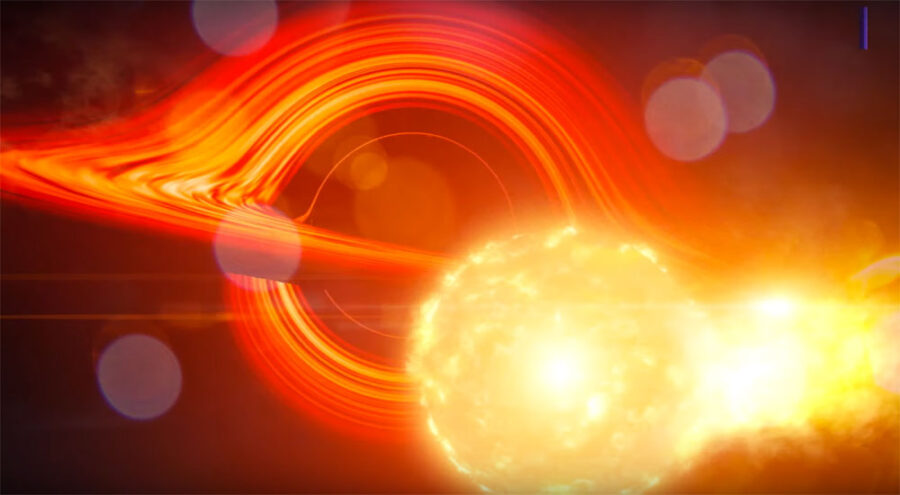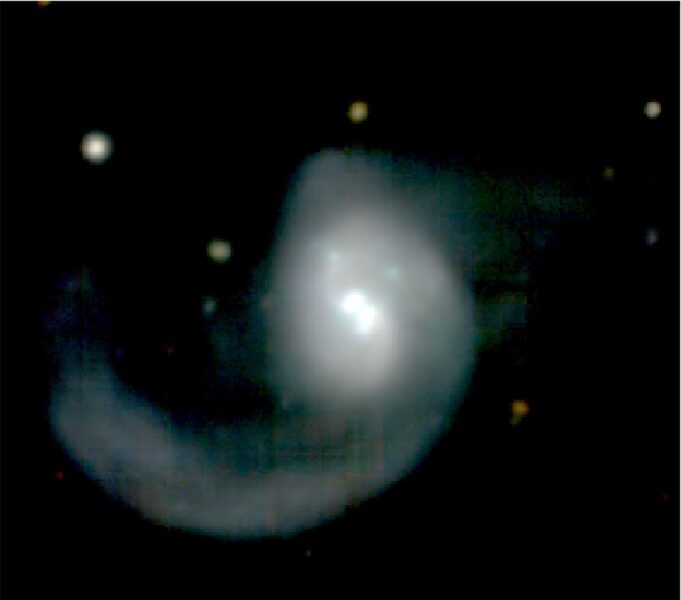Like a cosmic blinker, a distant supermassive black hole is flaring every 114 days. Astronomers believe the eerily regular signal betrays the piecemeal devouring of a star.

NASA's Goddard Space Flight Center
On November 14, 2014, the All-Sky Automated Survey for Supernovae (ASAS-SN), a global network of two-dozen 14-centimeter robot telescopes, detected a flare in the core of ESO 253-G003, a strangely shaped galaxy 570 million light-years away in the southern constellation Pictor. Catalogued as ASAS-SN 14ko, the flare was thought to be a supernova, or maybe a temporary brightening of an active galactic nucleus (AGN) powered by a supermassive black hole.
However, when Anna Payne (University of Hawai‘i, Mānoa) studied six years’ worth of data on the galaxy, she discovered that similar flare-ups occur every 114 days. AGNs often show quite dramatic brightness changes, but never in a fashion so regular, it’s reminiscent of the famous Old Faithful geyser in Yellowstone National Park.
“This behavior provided me with a unique opportunity to predict the next flare,” Payne told a press conference at the virtual 237th meeting of the American Astronomical Society. Three of the most recent flares (on May 17, September 7, and December 20, 2020) have now been studied by various ground-based facilities (including four large amateur telescopes in Australia, South Africa and Brazil), and by several X-ray space observatories: NASA’s Swift and NuSTAR satellites, and ESA’s XMM-Newton. The team has posted preliminary results on the arXiv preprint server.

Michael Tucker (University of Hawai’i) and the AMUSING survey
Each individual flare consists of a rapid, five-day rise in luminosity, followed by a much slower decline. As luck would have it, one earlier event, on November 7, 2018, was observed by the Transiting Exoplanet Survey Satellite (TESS), resulting in an extremely detailed light curve that traces how the brightness changes over time. According to Payne, the December 20, 2020, flare also occurred in TESS’s field of view, but she and her team have not analyzed those data yet.
Observations with the Multi Unit Spectroscopic Explorer on the European Southern Observatory’s Very Large Telescope reveal that ESO 253-G003 actually contains two actively feeding supermassive black holes, separated by some 4,500 light-years. In a second paper, submitted to Monthly Notices of the Royal Astronomical Society, a team led by Michael Tucker (also at the University of Hawai‘i, Mānoa) suggests that the galaxy is in the late stage of a major merger, which explains its irregular shape. The periodic flaring is seen in the brighter of the two nuclei.
So what causes the regular flares of ASAS-SN 14ko? They can’t be due to an interaction between the two black holes; they are too far apart and orbit each other much too slowly. Instead, Payne and her colleagues envision a star in an elongated orbit around the larger of the two black holes, which has an estimated mass of 80 million Suns or so. Every 114 days, the star passes dangerously close to the black hole, which rips away about three Jupiter masses’ worth of stellar material. This gas falls into the black hole, causing the flare. However, the star survives, only to lose another chunk at the next pass.
Close Encounters of the Supermassive Kind
Such periodic partial tidal disruption events (TDEs) were first studied theoretically in 1986 by Jean-Pierre Luminet (Laboratory of Astrophysics, Marseille, France). In fact, comments Luminet, “I’m surprised that this kind of event has not been detected earlier, because partial TDEs must be more frequent than complete TDEs, for which we already have a catalog of dozens of cases.”
Luminet’s calculations showed that a supermassive black hole’s tidal forces would rip apart a more or less homogenous Sun-like star if it ventured too close, or leave it unharmed if it remained at a safe enough distance. In contrast, at a range of distances, the black hole could tidally strip the low-density outer layers of a red giant, while the star’s dense core would remain intact. “Hence, a red giant can lose a few Jupiter masses at each passage along its periodic orbit,” he says.
Astronomers don’t know what kind of star is involved in ASAS-SN 14ko, or how long the AGN has been producing periodic flares. Therefore, it’s hard to tell how long the phenomenon will last, says Payne. The team plans to extensively study future flares, expected in April and August 2021.
There’s much to learn. Luminet recalls that when a low-density gas cloud, called G2, passed close to the supermassive black hole in the galactic center in 2014, most astronomers expected it to be destroyed by tidal forces, but nothing happened. “A lot of work remains to be done to better understand tidal disruption events,” he says.
 1
1









Comments
Andrew James
January 13, 2021 at 5:00 pm
“Hence, a red giant can lose a few Jupiter masses at each passage along its periodic orbit,” he says.
There are two things here. The orbit of the star is eccentric not circular. Combined with the gravitational differential between the side facing the black hole and the opposing side of the star. As a hypothesis, this likely causes clumping inside the star's radiative zone, where nearing/at perihelion the clump is eventually stripped off as a 'flare'. The process does not happen every orbit, likely because the star is still slowly rotating so the denser clump doesn't match the needed direction at the time of the perihelion passage to flare.
I'd think what is happening had something to do with the forces disrupting gas flows within the star - something very difficult to model. As the gas is transferred the orbit slowly decays, adding another variable to consider. The maths here is awful.
You must be logged in to post a comment.
You must be logged in to post a comment.